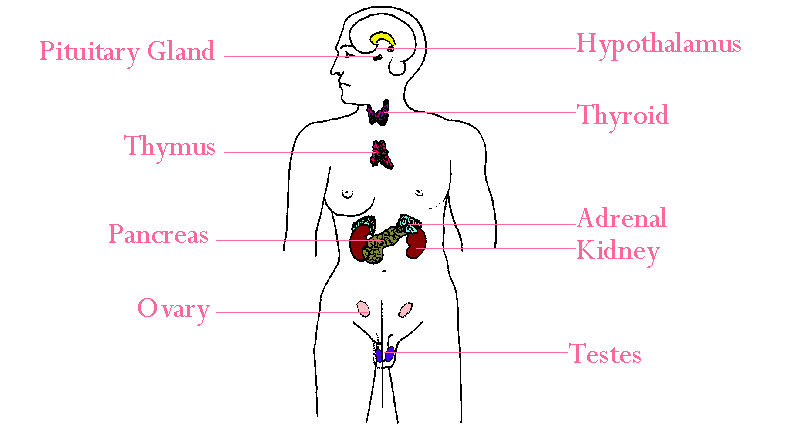
Hormone: a chemical messenger sent to a specific target cell.
Glands
Endocrine glands
Secrete products directly into the blood.Exocrine glandsExamples include the thyroid, pancreatic islets, and gonads.
Secrete products into ducts.Plant HormonesExamples include tear ducts, gastric glands, and sweat glands.
Auxin
Plays various roles in plant development.GibberellinsCell division, cell elongation, cell differentiation.
In shoots, stimulates meristematic growth, inhibits growth of lateral buds.
Induces production of xylem and differentiation of sexual parts.
Acts as a steroid hormone by signaling transcription.
Produced in the apical meristems of shoots and transported downward.
Elongation of stem cells.Inhibitors: inhibits effects of other hormones.Stimulation of leaf growth.
Signal starch digestion in seeds.
Response to environment.
Cytokinins
Interact with auxins during growth and fruit development.Endocrine GlandsStimulate seed production.
Produce in the apical meristems of roots and transported to the leaves and shoot.
Hypothalamus: region of the brain that controls the release of hormones.
Anterior Pituitary: the master gland made of endocrine tissue. Secretes hormones to signal endocrine glands to produce hormones.
Posterior Pituitary: organ made of nervous tissue that secretes hormones made by the hypothalamus.

Hormone Types
Protein hormones
Made from amino acids.Steroid hormonesBind to receptors outside the cell.
Examples: insulin, thyroxin
Manufactured from cholesterol.Animal HormonesLipid soluble.
Trigger transcription in the nucleus.
Examples: sex hormones.
Insulin
Produced in the pancreatic islets, located in the pancreas behind the stomach.GlucagonRegulates glucose uptake by cells from the blood stream.
Produced in the pancreatic islets, located in the pancreas behind the stomach.ThyroxinIncreases blood sugar levels by stimulating breakdown of glycogen.
Produced by the thyroid gland, located in the neck.Thyroid Stimulating Hormone (TSH)Affects the metabolic rate of every cell in the body.
Produced by the anterior pituitary at the base of the brain.OxytocinStimulates cells of the thyroid to produce thyroxin.
Secreted by the posterior pituitary gland at the base of the brain.VasopressinStimulates contractions of the uterus.
Causes milk ejection from the breasts of lactating women
Secreted by the posterior pituitary gland at the base of the brain.AdrenalinePrevents formation of large volumes of urine.
Produced by the adrenal glands located on top of the kidneys.Follicle Stimulating Hormone (FSH)Dilates blood vessels, increases blood pressure, increases blood sugar.
Produced in the anterior pituitary at the base of the brain.Luteinizing HormoneStimulates production of gametes in both sexes.
Produced by the anterior pituitary at the base of the brain.EstrogensStimulates secretion of sex hormones by gonads in both sexes.
Stimulates ovulation in females.
Secreted by the ovaries located in the female pelvic cavity.ProgesteroneSexual maturity in female mammals.
Produced by the ovaries in the female pelvic cavity.TestosteroneMaintenance of uterine endometrium.
Enlargement of breasts during pregnancy.
Produced by the testes located in the scrotum outside the male body.Human Chorionic GonadotropinSexual maturity in male mammals.
Sperm production.
Secreted by the placenta of pregnant females.CortisoneStimulates development and secretion by ovarian tissues.
Produced by the adrenal cortex located on top of the kidneys.GastrinMetabolism of carbohydrates, proteins, and fats.
Secreted by the stomach located in the upper portion of the abdominal cavity.SecretinStimulates secretion of hydrochloric acid by the stomach.
Produced by the cells of the small intestine located in the abdominal cavity.Feedback MechanismsStimulates release of sodium bicarbonate by the pancreas.
Inhibits acid production by the stomach.
Stimulates release of bile from the gall bladder.
Negative feedback
Change in a condition causes a change in activity to bring the situation back to the average.Positive feedbackExample: a thermostat that controls room temperature.
Change in a condition causes more of the same activity to continue.back to notes!Example: a bully who makes someone cry; reaction causes bully to continue bullying.